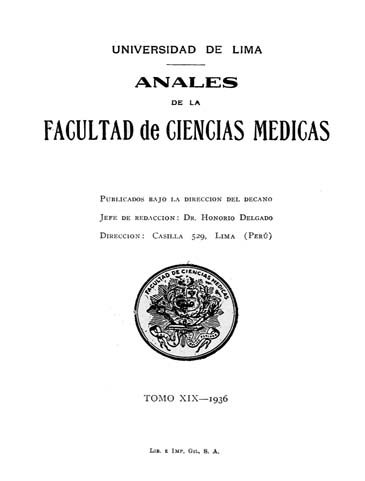Studies on the biological oxidation - The oxidation of ascorbic acid (vitamin C) in biological fluids
DOI:
https://doi.org/10.15381/anales.v19i1.9851Abstract
Biological fluids can be divided according to their behavior toward ascorbic acid into two groups: those having an inhibitory mechanism that protects the ascorbic acid oxidation, and those lacking this mechanism. Animal fluids and some of vegetable origin (those containing dosables amounts of ascorbic acid) corresponding to the first group. Ascorbic acid is protected from oxidation in the fluids by the action of copper catalyst. Fluids from plants (those that contain very little ascorbic acid) belong to the second group. Ascorbic acid is oxidized in these fluids by a variety of oxidizing catalysts, copper and hemocromógenos, as evidenced by the effect of inhibitors. The inhibitory effect of glutaction is specific to the catalytic action of ascorbic acid by hemocromógeno ferri-nicotine or yellow pumpkin juice.Downloads
Published
1936-07-20
Issue
Section
Trabajos originales
License
Copyright (c) 1936 E. S. Guzmán Barrón, Alberto Guzmán Barrón, Friedrich Klemperer

This work is licensed under a Creative Commons Attribution-NonCommercial-ShareAlike 4.0 International License.
Those authors who have publications with this magazine accept the following terms:
- Authors will retain their copyrights and guarantee the journal the right of first publication of their work, which will be simultaneously subject to Creative Commons Attribution License that allows third parties to share the work as long as its author and its first publication this magazine are indicated.
- Authors may adopt other non-exclusive licensing agreements for the distribution of the version of the published work (eg, deposit it in an institutional electronic file or publish it in a monographic volume) provided that the initial publication in this magazine is indicated.
- Authors are allowed and recommended to disseminate their work over the Internet (eg: in institutional telematic archives or on their website) before and during the submission process, which It can produce interesting exchanges and increase quotes from the published work. (See El efecto del acceso abierto ).
How to Cite
1.
Guzmán Barrón ES, Guzmán Barrón A, Klemperer F. Studies on the biological oxidation - The oxidation of ascorbic acid (vitamin C) in biological fluids. An Fac med [Internet]. 1936 Jul. 20 [cited 2024 Aug. 17];19(1):123-36. Available from: https://revistasinvestigacion.unmsm.edu.pe/index.php/anales/article/view/9851















